OHS/WHS Assessment Booklet 2: Short Answers, Analysis, and Research
VerifiedAdded on 2022/08/26
|30
|6731
|49
Homework Assignment
AI Summary
This assignment, focusing on Occupational Health and Safety (OHS/WHS), encompasses several key areas. It begins with short answer questions addressing OHS/WHS duties, management systems, and legislative guidelines, including relevant acts, regulations, and codes of practice. The assignment then delves into the creation and communication of company safety policies, along with internal documentation for compliance. A significant portion is dedicated to a detailed workplace inspection, specifically analyzing bricklaying activities, identifying hazards, and assessing risk ratings. This includes inspection criteria, methods, and frequency, with recommendations for improvements. Finally, the assignment concludes with a research and proposal section, outlining the relevant legislation, including common law and statute laws, and provides a tiling checklist and inspection details for building works supervision.
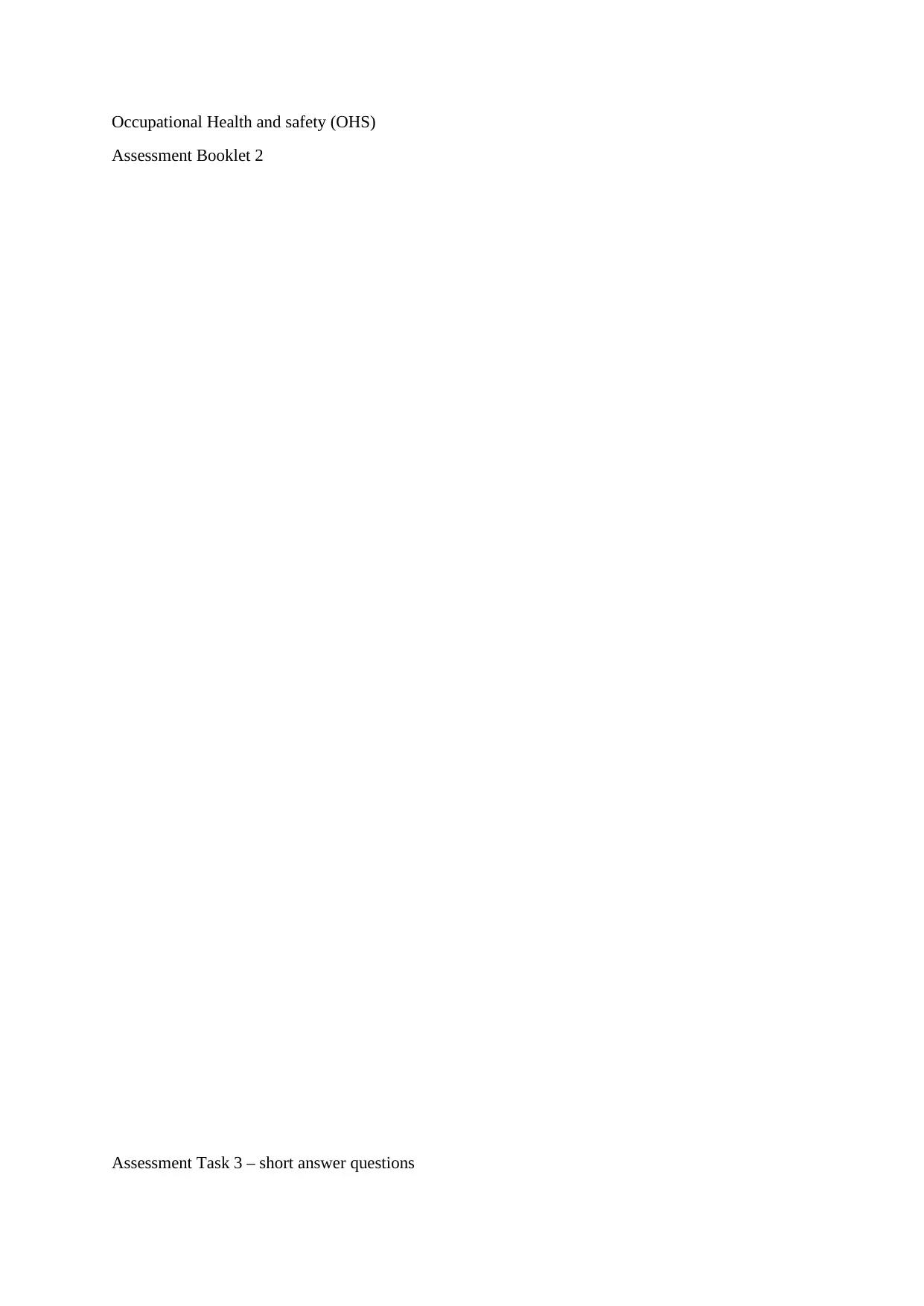
Occupational Health and safety (OHS)
Assessment Booklet 2
Assessment Task 3 – short answer questions
Assessment Booklet 2
Assessment Task 3 – short answer questions
Paraphrase This Document
Need a fresh take? Get an instant paraphrase of this document with our AI Paraphraser
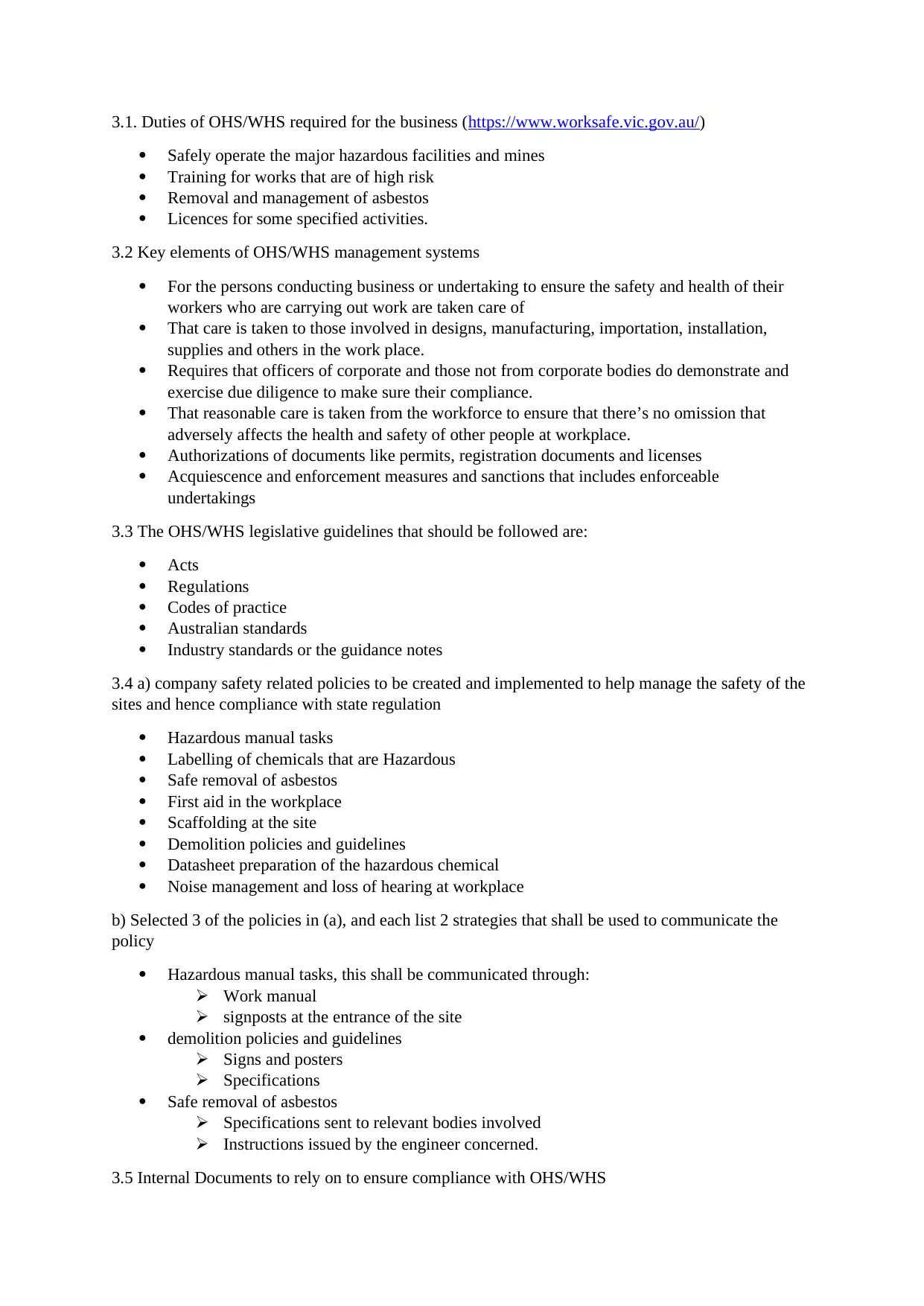
3.1. Duties of OHS/WHS required for the business (https://www.worksafe.vic.gov.au/)
Safely operate the major hazardous facilities and mines
Training for works that are of high risk
Removal and management of asbestos
Licences for some specified activities.
3.2 Key elements of OHS/WHS management systems
For the persons conducting business or undertaking to ensure the safety and health of their
workers who are carrying out work are taken care of
That care is taken to those involved in designs, manufacturing, importation, installation,
supplies and others in the work place.
Requires that officers of corporate and those not from corporate bodies do demonstrate and
exercise due diligence to make sure their compliance.
That reasonable care is taken from the workforce to ensure that there’s no omission that
adversely affects the health and safety of other people at workplace.
Authorizations of documents like permits, registration documents and licenses
Acquiescence and enforcement measures and sanctions that includes enforceable
undertakings
3.3 The OHS/WHS legislative guidelines that should be followed are:
Acts
Regulations
Codes of practice
Australian standards
Industry standards or the guidance notes
3.4 a) company safety related policies to be created and implemented to help manage the safety of the
sites and hence compliance with state regulation
Hazardous manual tasks
Labelling of chemicals that are Hazardous
Safe removal of asbestos
First aid in the workplace
Scaffolding at the site
Demolition policies and guidelines
Datasheet preparation of the hazardous chemical
Noise management and loss of hearing at workplace
b) Selected 3 of the policies in (a), and each list 2 strategies that shall be used to communicate the
policy
Hazardous manual tasks, this shall be communicated through:
Work manual
signposts at the entrance of the site
demolition policies and guidelines
Signs and posters
Specifications
Safe removal of asbestos
Specifications sent to relevant bodies involved
Instructions issued by the engineer concerned.
3.5 Internal Documents to rely on to ensure compliance with OHS/WHS
Safely operate the major hazardous facilities and mines
Training for works that are of high risk
Removal and management of asbestos
Licences for some specified activities.
3.2 Key elements of OHS/WHS management systems
For the persons conducting business or undertaking to ensure the safety and health of their
workers who are carrying out work are taken care of
That care is taken to those involved in designs, manufacturing, importation, installation,
supplies and others in the work place.
Requires that officers of corporate and those not from corporate bodies do demonstrate and
exercise due diligence to make sure their compliance.
That reasonable care is taken from the workforce to ensure that there’s no omission that
adversely affects the health and safety of other people at workplace.
Authorizations of documents like permits, registration documents and licenses
Acquiescence and enforcement measures and sanctions that includes enforceable
undertakings
3.3 The OHS/WHS legislative guidelines that should be followed are:
Acts
Regulations
Codes of practice
Australian standards
Industry standards or the guidance notes
3.4 a) company safety related policies to be created and implemented to help manage the safety of the
sites and hence compliance with state regulation
Hazardous manual tasks
Labelling of chemicals that are Hazardous
Safe removal of asbestos
First aid in the workplace
Scaffolding at the site
Demolition policies and guidelines
Datasheet preparation of the hazardous chemical
Noise management and loss of hearing at workplace
b) Selected 3 of the policies in (a), and each list 2 strategies that shall be used to communicate the
policy
Hazardous manual tasks, this shall be communicated through:
Work manual
signposts at the entrance of the site
demolition policies and guidelines
Signs and posters
Specifications
Safe removal of asbestos
Specifications sent to relevant bodies involved
Instructions issued by the engineer concerned.
3.5 Internal Documents to rely on to ensure compliance with OHS/WHS
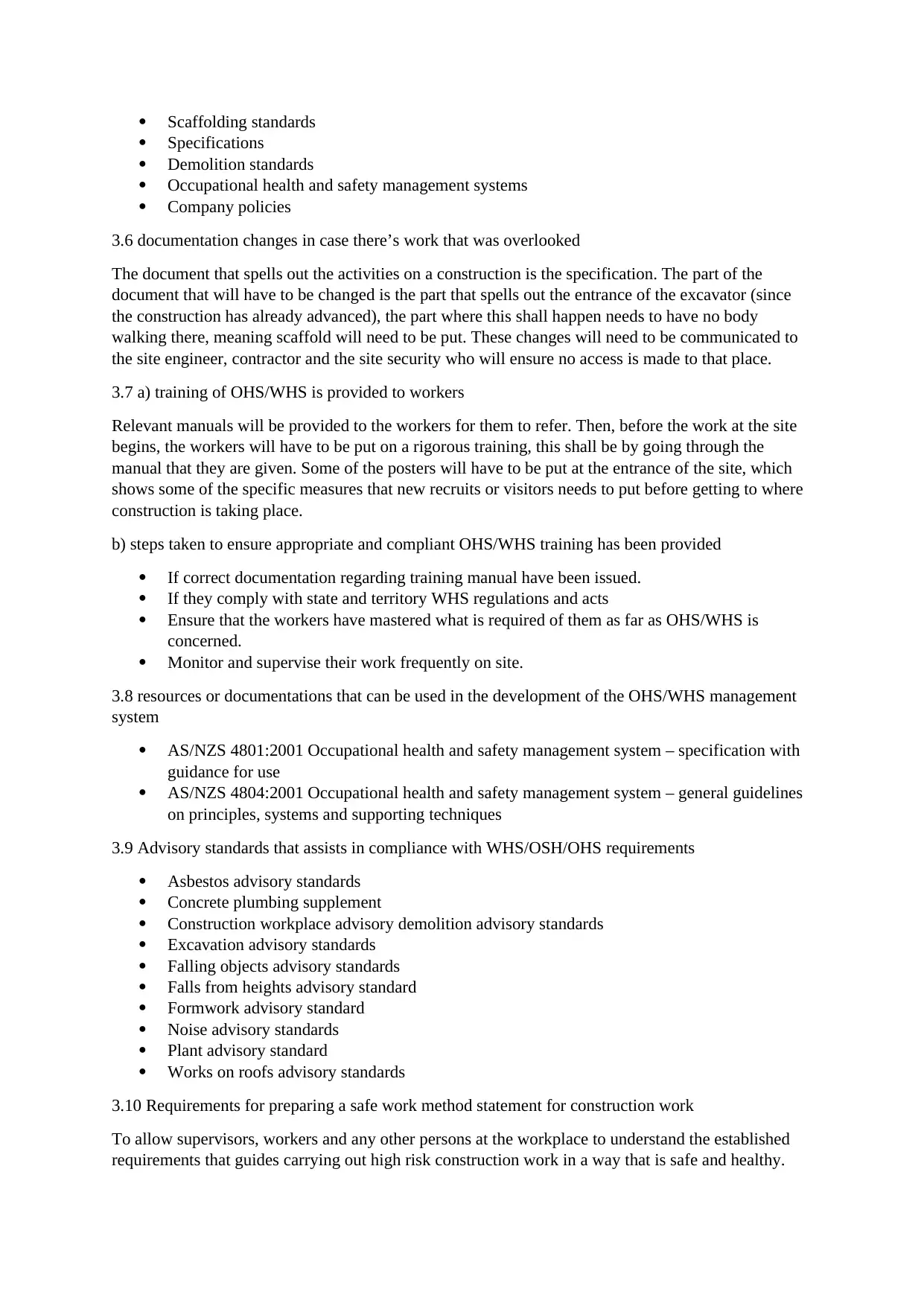
Scaffolding standards
Specifications
Demolition standards
Occupational health and safety management systems
Company policies
3.6 documentation changes in case there’s work that was overlooked
The document that spells out the activities on a construction is the specification. The part of the
document that will have to be changed is the part that spells out the entrance of the excavator (since
the construction has already advanced), the part where this shall happen needs to have no body
walking there, meaning scaffold will need to be put. These changes will need to be communicated to
the site engineer, contractor and the site security who will ensure no access is made to that place.
3.7 a) training of OHS/WHS is provided to workers
Relevant manuals will be provided to the workers for them to refer. Then, before the work at the site
begins, the workers will have to be put on a rigorous training, this shall be by going through the
manual that they are given. Some of the posters will have to be put at the entrance of the site, which
shows some of the specific measures that new recruits or visitors needs to put before getting to where
construction is taking place.
b) steps taken to ensure appropriate and compliant OHS/WHS training has been provided
If correct documentation regarding training manual have been issued.
If they comply with state and territory WHS regulations and acts
Ensure that the workers have mastered what is required of them as far as OHS/WHS is
concerned.
Monitor and supervise their work frequently on site.
3.8 resources or documentations that can be used in the development of the OHS/WHS management
system
AS/NZS 4801:2001 Occupational health and safety management system – specification with
guidance for use
AS/NZS 4804:2001 Occupational health and safety management system – general guidelines
on principles, systems and supporting techniques
3.9 Advisory standards that assists in compliance with WHS/OSH/OHS requirements
Asbestos advisory standards
Concrete plumbing supplement
Construction workplace advisory demolition advisory standards
Excavation advisory standards
Falling objects advisory standards
Falls from heights advisory standard
Formwork advisory standard
Noise advisory standards
Plant advisory standard
Works on roofs advisory standards
3.10 Requirements for preparing a safe work method statement for construction work
To allow supervisors, workers and any other persons at the workplace to understand the established
requirements that guides carrying out high risk construction work in a way that is safe and healthy.
Specifications
Demolition standards
Occupational health and safety management systems
Company policies
3.6 documentation changes in case there’s work that was overlooked
The document that spells out the activities on a construction is the specification. The part of the
document that will have to be changed is the part that spells out the entrance of the excavator (since
the construction has already advanced), the part where this shall happen needs to have no body
walking there, meaning scaffold will need to be put. These changes will need to be communicated to
the site engineer, contractor and the site security who will ensure no access is made to that place.
3.7 a) training of OHS/WHS is provided to workers
Relevant manuals will be provided to the workers for them to refer. Then, before the work at the site
begins, the workers will have to be put on a rigorous training, this shall be by going through the
manual that they are given. Some of the posters will have to be put at the entrance of the site, which
shows some of the specific measures that new recruits or visitors needs to put before getting to where
construction is taking place.
b) steps taken to ensure appropriate and compliant OHS/WHS training has been provided
If correct documentation regarding training manual have been issued.
If they comply with state and territory WHS regulations and acts
Ensure that the workers have mastered what is required of them as far as OHS/WHS is
concerned.
Monitor and supervise their work frequently on site.
3.8 resources or documentations that can be used in the development of the OHS/WHS management
system
AS/NZS 4801:2001 Occupational health and safety management system – specification with
guidance for use
AS/NZS 4804:2001 Occupational health and safety management system – general guidelines
on principles, systems and supporting techniques
3.9 Advisory standards that assists in compliance with WHS/OSH/OHS requirements
Asbestos advisory standards
Concrete plumbing supplement
Construction workplace advisory demolition advisory standards
Excavation advisory standards
Falling objects advisory standards
Falls from heights advisory standard
Formwork advisory standard
Noise advisory standards
Plant advisory standard
Works on roofs advisory standards
3.10 Requirements for preparing a safe work method statement for construction work
To allow supervisors, workers and any other persons at the workplace to understand the established
requirements that guides carrying out high risk construction work in a way that is safe and healthy.
⊘ This is a preview!⊘
Do you want full access?
Subscribe today to unlock all pages.

Trusted by 1+ million students worldwide
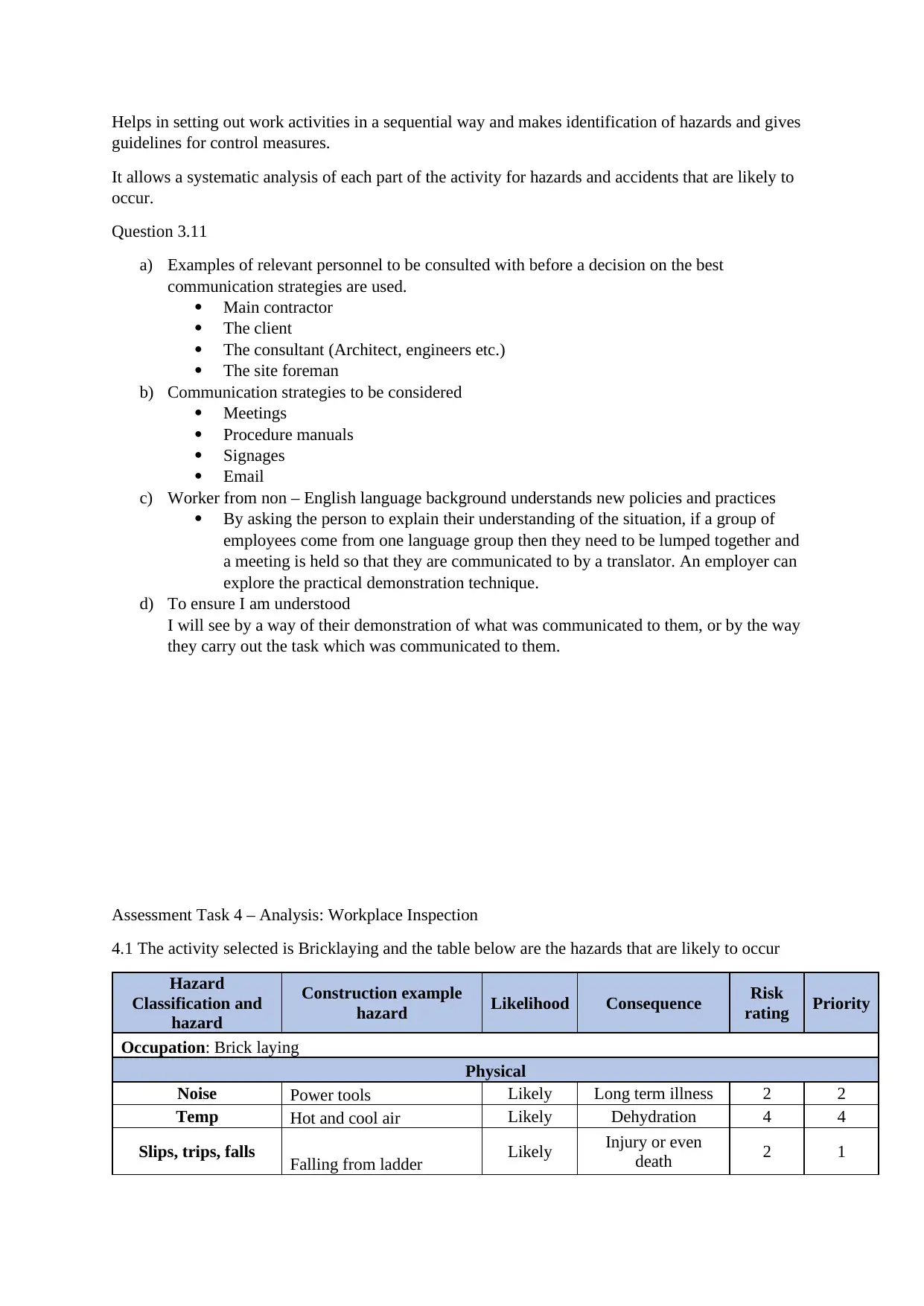
Helps in setting out work activities in a sequential way and makes identification of hazards and gives
guidelines for control measures.
It allows a systematic analysis of each part of the activity for hazards and accidents that are likely to
occur.
Question 3.11
a) Examples of relevant personnel to be consulted with before a decision on the best
communication strategies are used.
Main contractor
The client
The consultant (Architect, engineers etc.)
The site foreman
b) Communication strategies to be considered
Meetings
Procedure manuals
Signages
Email
c) Worker from non – English language background understands new policies and practices
By asking the person to explain their understanding of the situation, if a group of
employees come from one language group then they need to be lumped together and
a meeting is held so that they are communicated to by a translator. An employer can
explore the practical demonstration technique.
d) To ensure I am understood
I will see by a way of their demonstration of what was communicated to them, or by the way
they carry out the task which was communicated to them.
Assessment Task 4 – Analysis: Workplace Inspection
4.1 The activity selected is Bricklaying and the table below are the hazards that are likely to occur
Hazard
Classification and
hazard
Construction example
hazard Likelihood Consequence Risk
rating Priority
Occupation: Brick laying
Physical
Noise Power tools Likely Long term illness 2 2
Temp Hot and cool air Likely Dehydration 4 4
Slips, trips, falls Falling from ladder Likely Injury or even
death 2 1
guidelines for control measures.
It allows a systematic analysis of each part of the activity for hazards and accidents that are likely to
occur.
Question 3.11
a) Examples of relevant personnel to be consulted with before a decision on the best
communication strategies are used.
Main contractor
The client
The consultant (Architect, engineers etc.)
The site foreman
b) Communication strategies to be considered
Meetings
Procedure manuals
Signages
c) Worker from non – English language background understands new policies and practices
By asking the person to explain their understanding of the situation, if a group of
employees come from one language group then they need to be lumped together and
a meeting is held so that they are communicated to by a translator. An employer can
explore the practical demonstration technique.
d) To ensure I am understood
I will see by a way of their demonstration of what was communicated to them, or by the way
they carry out the task which was communicated to them.
Assessment Task 4 – Analysis: Workplace Inspection
4.1 The activity selected is Bricklaying and the table below are the hazards that are likely to occur
Hazard
Classification and
hazard
Construction example
hazard Likelihood Consequence Risk
rating Priority
Occupation: Brick laying
Physical
Noise Power tools Likely Long term illness 2 2
Temp Hot and cool air Likely Dehydration 4 4
Slips, trips, falls Falling from ladder Likely Injury or even
death 2 1
Paraphrase This Document
Need a fresh take? Get an instant paraphrase of this document with our AI Paraphraser
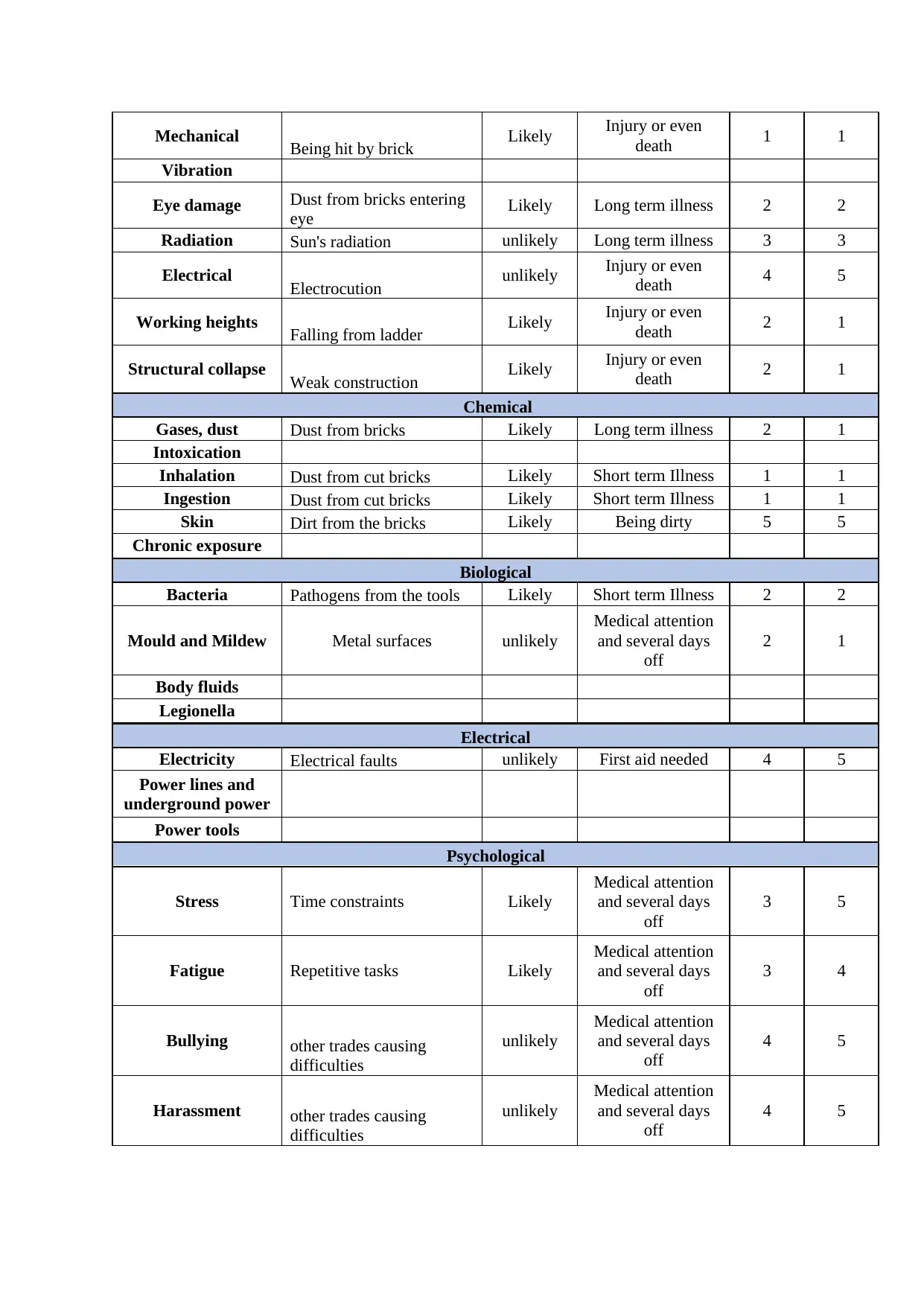
Mechanical Being hit by brick Likely Injury or even
death 1 1
Vibration
Eye damage Dust from bricks entering
eye Likely Long term illness 2 2
Radiation Sun's radiation unlikely Long term illness 3 3
Electrical Electrocution unlikely Injury or even
death 4 5
Working heights Falling from ladder Likely Injury or even
death 2 1
Structural collapse Weak construction Likely Injury or even
death 2 1
Chemical
Gases, dust Dust from bricks Likely Long term illness 2 1
Intoxication
Inhalation Dust from cut bricks Likely Short term Illness 1 1
Ingestion Dust from cut bricks Likely Short term Illness 1 1
Skin Dirt from the bricks Likely Being dirty 5 5
Chronic exposure
Biological
Bacteria Pathogens from the tools Likely Short term Illness 2 2
Mould and Mildew Metal surfaces unlikely
Medical attention
and several days
off
2 1
Body fluids
Legionella
Electrical
Electricity Electrical faults unlikely First aid needed 4 5
Power lines and
underground power
Power tools
Psychological
Stress Time constraints Likely
Medical attention
and several days
off
3 5
Fatigue Repetitive tasks Likely
Medical attention
and several days
off
3 4
Bullying other trades causing
difficulties
unlikely
Medical attention
and several days
off
4 5
Harassment other trades causing
difficulties
unlikely
Medical attention
and several days
off
4 5
death 1 1
Vibration
Eye damage Dust from bricks entering
eye Likely Long term illness 2 2
Radiation Sun's radiation unlikely Long term illness 3 3
Electrical Electrocution unlikely Injury or even
death 4 5
Working heights Falling from ladder Likely Injury or even
death 2 1
Structural collapse Weak construction Likely Injury or even
death 2 1
Chemical
Gases, dust Dust from bricks Likely Long term illness 2 1
Intoxication
Inhalation Dust from cut bricks Likely Short term Illness 1 1
Ingestion Dust from cut bricks Likely Short term Illness 1 1
Skin Dirt from the bricks Likely Being dirty 5 5
Chronic exposure
Biological
Bacteria Pathogens from the tools Likely Short term Illness 2 2
Mould and Mildew Metal surfaces unlikely
Medical attention
and several days
off
2 1
Body fluids
Legionella
Electrical
Electricity Electrical faults unlikely First aid needed 4 5
Power lines and
underground power
Power tools
Psychological
Stress Time constraints Likely
Medical attention
and several days
off
3 5
Fatigue Repetitive tasks Likely
Medical attention
and several days
off
3 4
Bullying other trades causing
difficulties
unlikely
Medical attention
and several days
off
4 5
Harassment other trades causing
difficulties
unlikely
Medical attention
and several days
off
4 5
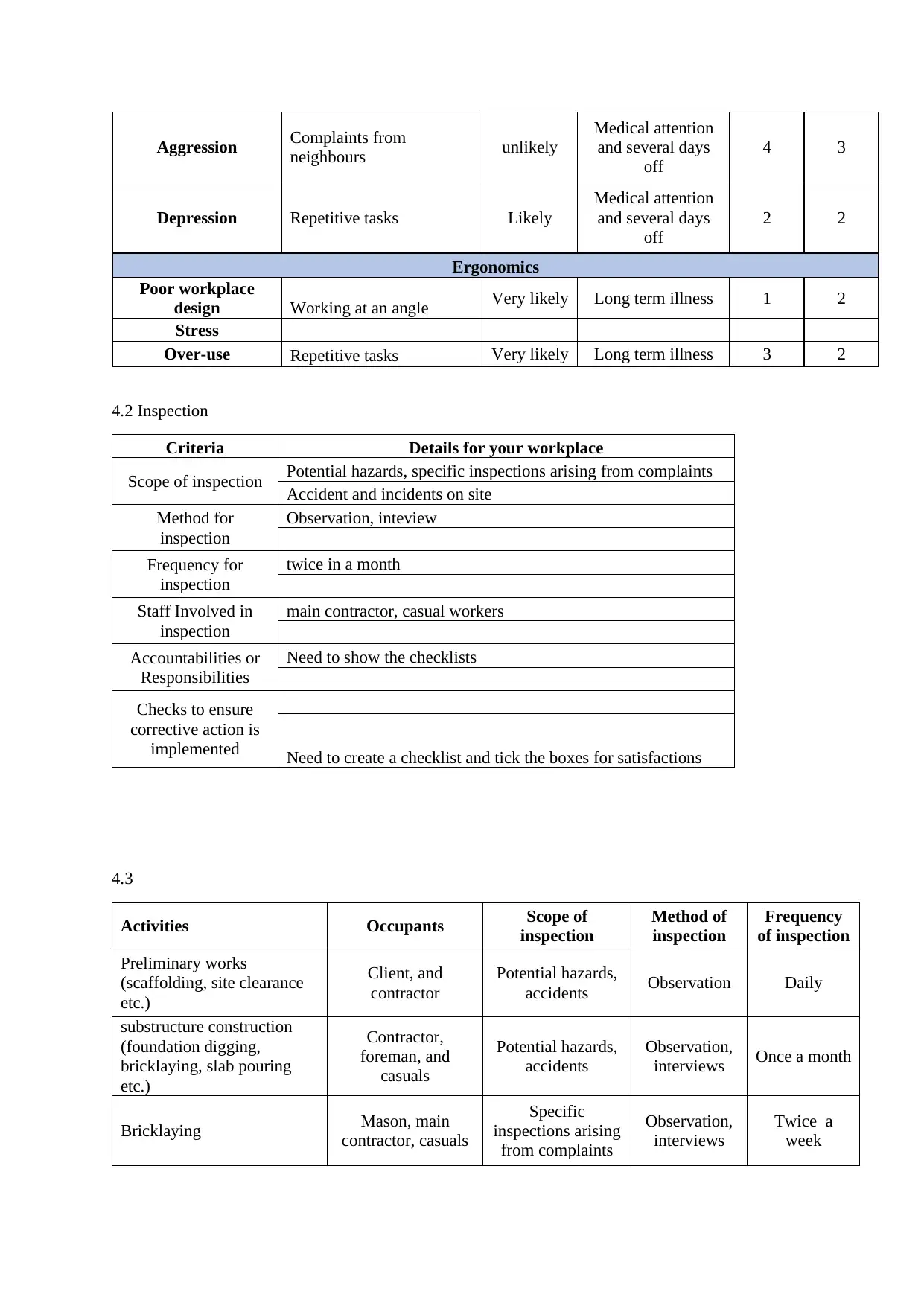
Aggression Complaints from
neighbours unlikely
Medical attention
and several days
off
4 3
Depression Repetitive tasks Likely
Medical attention
and several days
off
2 2
Ergonomics
Poor workplace
design Working at an angle Very likely Long term illness 1 2
Stress
Over-use Repetitive tasks Very likely Long term illness 3 2
4.2 Inspection
Criteria Details for your workplace
Scope of inspection Potential hazards, specific inspections arising from complaints
Accident and incidents on site
Method for
inspection
Observation, inteview
Frequency for
inspection
twice in a month
Staff Involved in
inspection
main contractor, casual workers
Accountabilities or
Responsibilities
Need to show the checklists
Checks to ensure
corrective action is
implemented Need to create a checklist and tick the boxes for satisfactions
4.3
Activities Occupants Scope of
inspection
Method of
inspection
Frequency
of inspection
Preliminary works
(scaffolding, site clearance
etc.)
Client, and
contractor
Potential hazards,
accidents Observation Daily
substructure construction
(foundation digging,
bricklaying, slab pouring
etc.)
Contractor,
foreman, and
casuals
Potential hazards,
accidents
Observation,
interviews Once a month
Bricklaying Mason, main
contractor, casuals
Specific
inspections arising
from complaints
Observation,
interviews
Twice a
week
neighbours unlikely
Medical attention
and several days
off
4 3
Depression Repetitive tasks Likely
Medical attention
and several days
off
2 2
Ergonomics
Poor workplace
design Working at an angle Very likely Long term illness 1 2
Stress
Over-use Repetitive tasks Very likely Long term illness 3 2
4.2 Inspection
Criteria Details for your workplace
Scope of inspection Potential hazards, specific inspections arising from complaints
Accident and incidents on site
Method for
inspection
Observation, inteview
Frequency for
inspection
twice in a month
Staff Involved in
inspection
main contractor, casual workers
Accountabilities or
Responsibilities
Need to show the checklists
Checks to ensure
corrective action is
implemented Need to create a checklist and tick the boxes for satisfactions
4.3
Activities Occupants Scope of
inspection
Method of
inspection
Frequency
of inspection
Preliminary works
(scaffolding, site clearance
etc.)
Client, and
contractor
Potential hazards,
accidents Observation Daily
substructure construction
(foundation digging,
bricklaying, slab pouring
etc.)
Contractor,
foreman, and
casuals
Potential hazards,
accidents
Observation,
interviews Once a month
Bricklaying Mason, main
contractor, casuals
Specific
inspections arising
from complaints
Observation,
interviews
Twice a
week
⊘ This is a preview!⊘
Do you want full access?
Subscribe today to unlock all pages.

Trusted by 1+ million students worldwide
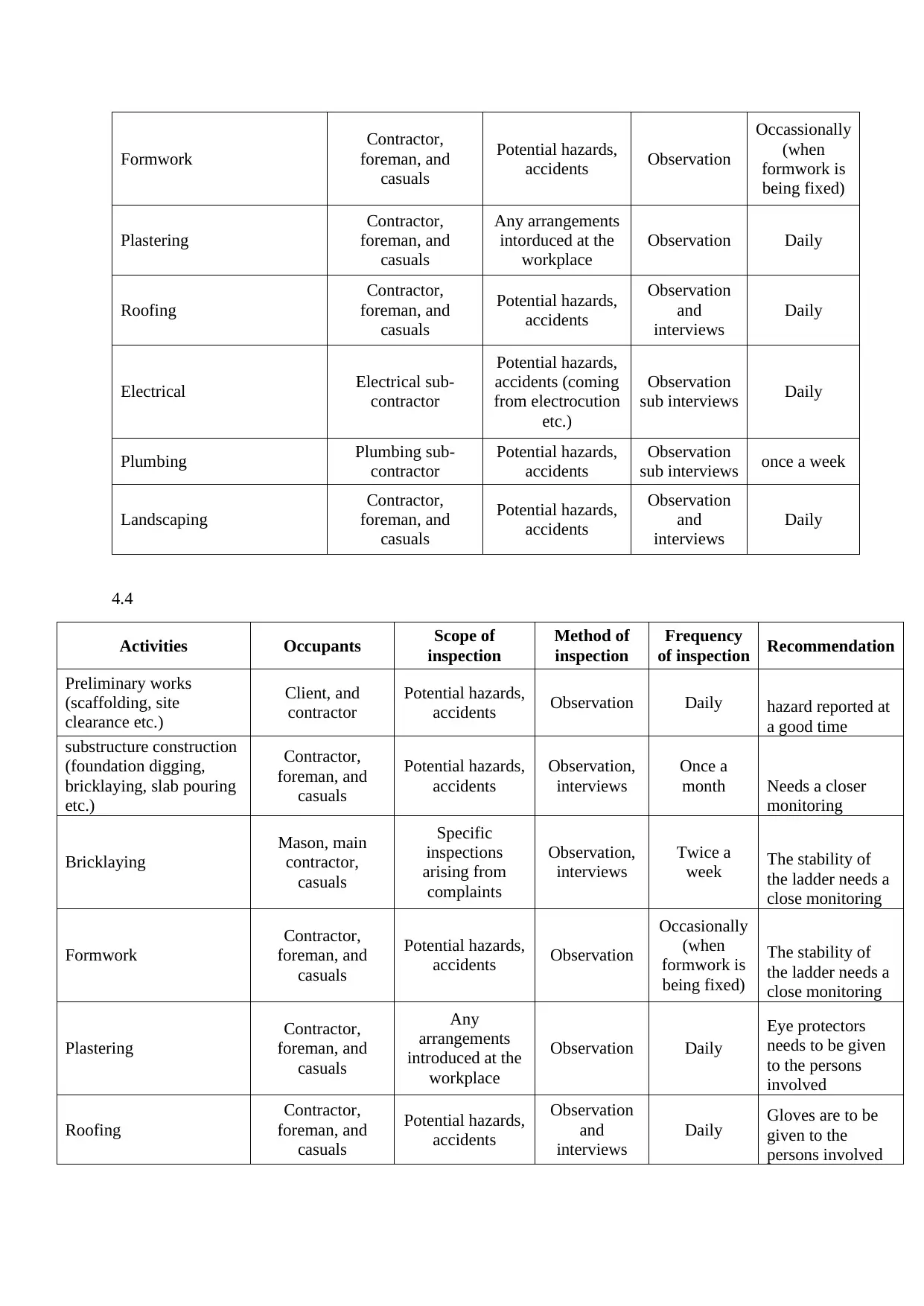
Formwork
Contractor,
foreman, and
casuals
Potential hazards,
accidents Observation
Occassionally
(when
formwork is
being fixed)
Plastering
Contractor,
foreman, and
casuals
Any arrangements
intorduced at the
workplace
Observation Daily
Roofing
Contractor,
foreman, and
casuals
Potential hazards,
accidents
Observation
and
interviews
Daily
Electrical Electrical sub-
contractor
Potential hazards,
accidents (coming
from electrocution
etc.)
Observation
sub interviews Daily
Plumbing Plumbing sub-
contractor
Potential hazards,
accidents
Observation
sub interviews once a week
Landscaping
Contractor,
foreman, and
casuals
Potential hazards,
accidents
Observation
and
interviews
Daily
4.4
Activities Occupants Scope of
inspection
Method of
inspection
Frequency
of inspection Recommendation
Preliminary works
(scaffolding, site
clearance etc.)
Client, and
contractor
Potential hazards,
accidents Observation Daily hazard reported at
a good time
substructure construction
(foundation digging,
bricklaying, slab pouring
etc.)
Contractor,
foreman, and
casuals
Potential hazards,
accidents
Observation,
interviews
Once a
month Needs a closer
monitoring
Bricklaying
Mason, main
contractor,
casuals
Specific
inspections
arising from
complaints
Observation,
interviews
Twice a
week The stability of
the ladder needs a
close monitoring
Formwork
Contractor,
foreman, and
casuals
Potential hazards,
accidents Observation
Occasionally
(when
formwork is
being fixed)
The stability of
the ladder needs a
close monitoring
Plastering
Contractor,
foreman, and
casuals
Any
arrangements
introduced at the
workplace
Observation Daily
Eye protectors
needs to be given
to the persons
involved
Roofing
Contractor,
foreman, and
casuals
Potential hazards,
accidents
Observation
and
interviews
Daily Gloves are to be
given to the
persons involved
Contractor,
foreman, and
casuals
Potential hazards,
accidents Observation
Occassionally
(when
formwork is
being fixed)
Plastering
Contractor,
foreman, and
casuals
Any arrangements
intorduced at the
workplace
Observation Daily
Roofing
Contractor,
foreman, and
casuals
Potential hazards,
accidents
Observation
and
interviews
Daily
Electrical Electrical sub-
contractor
Potential hazards,
accidents (coming
from electrocution
etc.)
Observation
sub interviews Daily
Plumbing Plumbing sub-
contractor
Potential hazards,
accidents
Observation
sub interviews once a week
Landscaping
Contractor,
foreman, and
casuals
Potential hazards,
accidents
Observation
and
interviews
Daily
4.4
Activities Occupants Scope of
inspection
Method of
inspection
Frequency
of inspection Recommendation
Preliminary works
(scaffolding, site
clearance etc.)
Client, and
contractor
Potential hazards,
accidents Observation Daily hazard reported at
a good time
substructure construction
(foundation digging,
bricklaying, slab pouring
etc.)
Contractor,
foreman, and
casuals
Potential hazards,
accidents
Observation,
interviews
Once a
month Needs a closer
monitoring
Bricklaying
Mason, main
contractor,
casuals
Specific
inspections
arising from
complaints
Observation,
interviews
Twice a
week The stability of
the ladder needs a
close monitoring
Formwork
Contractor,
foreman, and
casuals
Potential hazards,
accidents Observation
Occasionally
(when
formwork is
being fixed)
The stability of
the ladder needs a
close monitoring
Plastering
Contractor,
foreman, and
casuals
Any
arrangements
introduced at the
workplace
Observation Daily
Eye protectors
needs to be given
to the persons
involved
Roofing
Contractor,
foreman, and
casuals
Potential hazards,
accidents
Observation
and
interviews
Daily Gloves are to be
given to the
persons involved
Paraphrase This Document
Need a fresh take? Get an instant paraphrase of this document with our AI Paraphraser
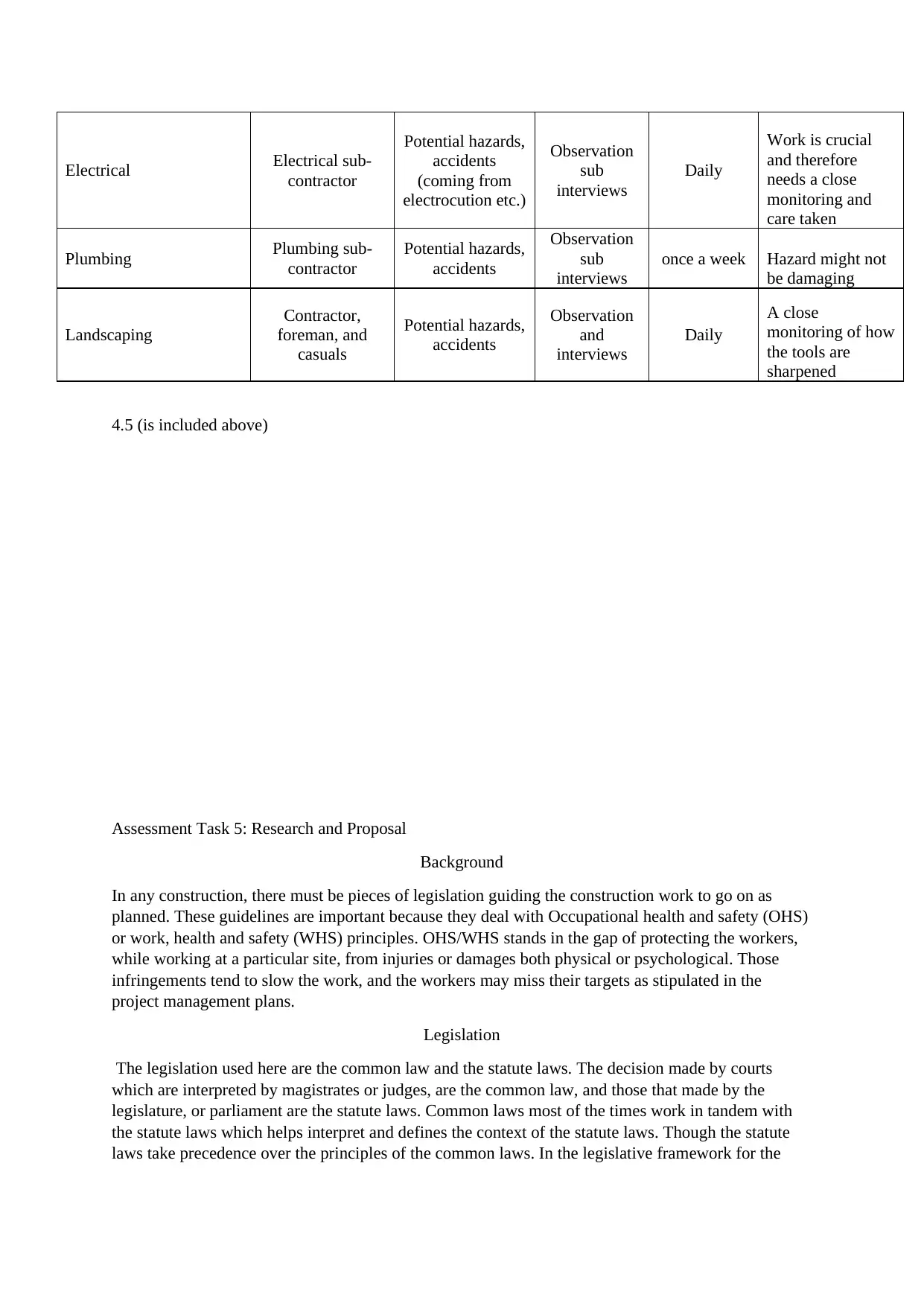
Electrical Electrical sub-
contractor
Potential hazards,
accidents
(coming from
electrocution etc.)
Observation
sub
interviews
Daily
Work is crucial
and therefore
needs a close
monitoring and
care taken
Plumbing Plumbing sub-
contractor
Potential hazards,
accidents
Observation
sub
interviews
once a week Hazard might not
be damaging
Landscaping
Contractor,
foreman, and
casuals
Potential hazards,
accidents
Observation
and
interviews
Daily
A close
monitoring of how
the tools are
sharpened
4.5 (is included above)
Assessment Task 5: Research and Proposal
Background
In any construction, there must be pieces of legislation guiding the construction work to go on as
planned. These guidelines are important because they deal with Occupational health and safety (OHS)
or work, health and safety (WHS) principles. OHS/WHS stands in the gap of protecting the workers,
while working at a particular site, from injuries or damages both physical or psychological. Those
infringements tend to slow the work, and the workers may miss their targets as stipulated in the
project management plans.
Legislation
The legislation used here are the common law and the statute laws. The decision made by courts
which are interpreted by magistrates or judges, are the common law, and those that made by the
legislature, or parliament are the statute laws. Common laws most of the times work in tandem with
the statute laws which helps interpret and defines the context of the statute laws. Though the statute
laws take precedence over the principles of the common laws. In the legislative framework for the
contractor
Potential hazards,
accidents
(coming from
electrocution etc.)
Observation
sub
interviews
Daily
Work is crucial
and therefore
needs a close
monitoring and
care taken
Plumbing Plumbing sub-
contractor
Potential hazards,
accidents
Observation
sub
interviews
once a week Hazard might not
be damaging
Landscaping
Contractor,
foreman, and
casuals
Potential hazards,
accidents
Observation
and
interviews
Daily
A close
monitoring of how
the tools are
sharpened
4.5 (is included above)
Assessment Task 5: Research and Proposal
Background
In any construction, there must be pieces of legislation guiding the construction work to go on as
planned. These guidelines are important because they deal with Occupational health and safety (OHS)
or work, health and safety (WHS) principles. OHS/WHS stands in the gap of protecting the workers,
while working at a particular site, from injuries or damages both physical or psychological. Those
infringements tend to slow the work, and the workers may miss their targets as stipulated in the
project management plans.
Legislation
The legislation used here are the common law and the statute laws. The decision made by courts
which are interpreted by magistrates or judges, are the common law, and those that made by the
legislature, or parliament are the statute laws. Common laws most of the times work in tandem with
the statute laws which helps interpret and defines the context of the statute laws. Though the statute
laws take precedence over the principles of the common laws. In the legislative framework for the
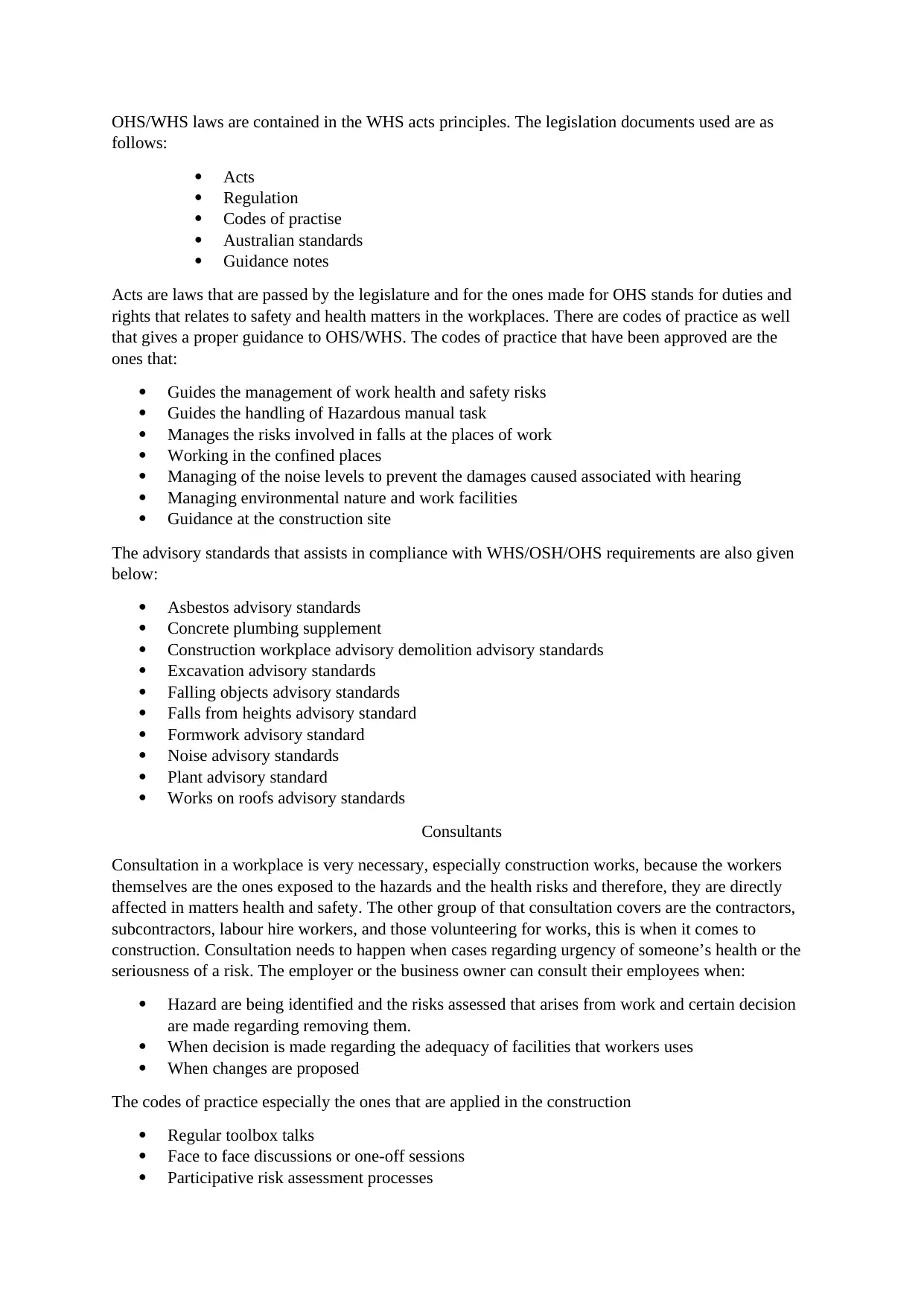
OHS/WHS laws are contained in the WHS acts principles. The legislation documents used are as
follows:
Acts
Regulation
Codes of practise
Australian standards
Guidance notes
Acts are laws that are passed by the legislature and for the ones made for OHS stands for duties and
rights that relates to safety and health matters in the workplaces. There are codes of practice as well
that gives a proper guidance to OHS/WHS. The codes of practice that have been approved are the
ones that:
Guides the management of work health and safety risks
Guides the handling of Hazardous manual task
Manages the risks involved in falls at the places of work
Working in the confined places
Managing of the noise levels to prevent the damages caused associated with hearing
Managing environmental nature and work facilities
Guidance at the construction site
The advisory standards that assists in compliance with WHS/OSH/OHS requirements are also given
below:
Asbestos advisory standards
Concrete plumbing supplement
Construction workplace advisory demolition advisory standards
Excavation advisory standards
Falling objects advisory standards
Falls from heights advisory standard
Formwork advisory standard
Noise advisory standards
Plant advisory standard
Works on roofs advisory standards
Consultants
Consultation in a workplace is very necessary, especially construction works, because the workers
themselves are the ones exposed to the hazards and the health risks and therefore, they are directly
affected in matters health and safety. The other group of that consultation covers are the contractors,
subcontractors, labour hire workers, and those volunteering for works, this is when it comes to
construction. Consultation needs to happen when cases regarding urgency of someone’s health or the
seriousness of a risk. The employer or the business owner can consult their employees when:
Hazard are being identified and the risks assessed that arises from work and certain decision
are made regarding removing them.
When decision is made regarding the adequacy of facilities that workers uses
When changes are proposed
The codes of practice especially the ones that are applied in the construction
Regular toolbox talks
Face to face discussions or one-off sessions
Participative risk assessment processes
follows:
Acts
Regulation
Codes of practise
Australian standards
Guidance notes
Acts are laws that are passed by the legislature and for the ones made for OHS stands for duties and
rights that relates to safety and health matters in the workplaces. There are codes of practice as well
that gives a proper guidance to OHS/WHS. The codes of practice that have been approved are the
ones that:
Guides the management of work health and safety risks
Guides the handling of Hazardous manual task
Manages the risks involved in falls at the places of work
Working in the confined places
Managing of the noise levels to prevent the damages caused associated with hearing
Managing environmental nature and work facilities
Guidance at the construction site
The advisory standards that assists in compliance with WHS/OSH/OHS requirements are also given
below:
Asbestos advisory standards
Concrete plumbing supplement
Construction workplace advisory demolition advisory standards
Excavation advisory standards
Falling objects advisory standards
Falls from heights advisory standard
Formwork advisory standard
Noise advisory standards
Plant advisory standard
Works on roofs advisory standards
Consultants
Consultation in a workplace is very necessary, especially construction works, because the workers
themselves are the ones exposed to the hazards and the health risks and therefore, they are directly
affected in matters health and safety. The other group of that consultation covers are the contractors,
subcontractors, labour hire workers, and those volunteering for works, this is when it comes to
construction. Consultation needs to happen when cases regarding urgency of someone’s health or the
seriousness of a risk. The employer or the business owner can consult their employees when:
Hazard are being identified and the risks assessed that arises from work and certain decision
are made regarding removing them.
When decision is made regarding the adequacy of facilities that workers uses
When changes are proposed
The codes of practice especially the ones that are applied in the construction
Regular toolbox talks
Face to face discussions or one-off sessions
Participative risk assessment processes
⊘ This is a preview!⊘
Do you want full access?
Subscribe today to unlock all pages.

Trusted by 1+ million students worldwide
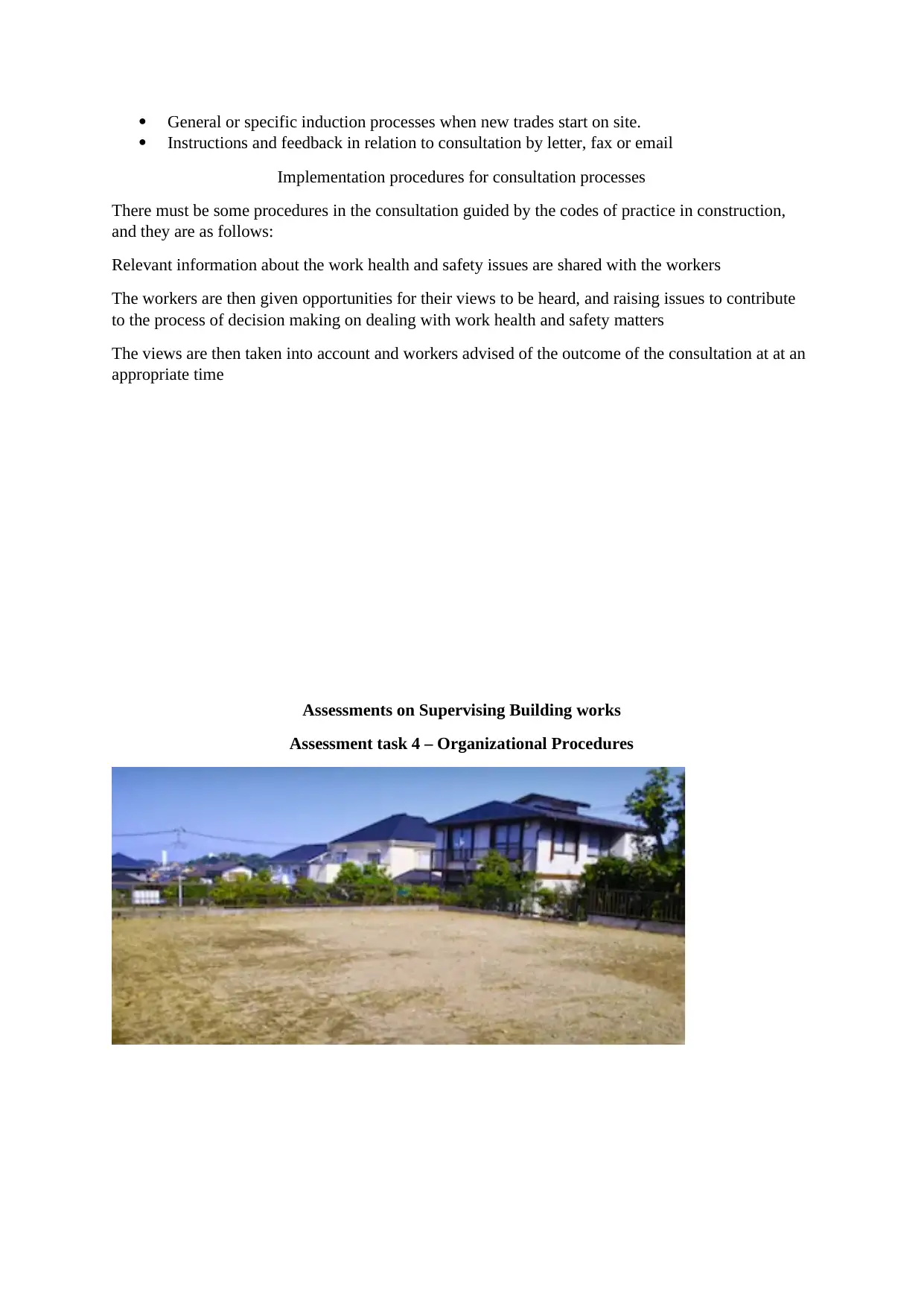
General or specific induction processes when new trades start on site.
Instructions and feedback in relation to consultation by letter, fax or email
Implementation procedures for consultation processes
There must be some procedures in the consultation guided by the codes of practice in construction,
and they are as follows:
Relevant information about the work health and safety issues are shared with the workers
The workers are then given opportunities for their views to be heard, and raising issues to contribute
to the process of decision making on dealing with work health and safety matters
The views are then taken into account and workers advised of the outcome of the consultation at at an
appropriate time
Assessments on Supervising Building works
Assessment task 4 – Organizational Procedures
Instructions and feedback in relation to consultation by letter, fax or email
Implementation procedures for consultation processes
There must be some procedures in the consultation guided by the codes of practice in construction,
and they are as follows:
Relevant information about the work health and safety issues are shared with the workers
The workers are then given opportunities for their views to be heard, and raising issues to contribute
to the process of decision making on dealing with work health and safety matters
The views are then taken into account and workers advised of the outcome of the consultation at at an
appropriate time
Assessments on Supervising Building works
Assessment task 4 – Organizational Procedures
Paraphrase This Document
Need a fresh take? Get an instant paraphrase of this document with our AI Paraphraser
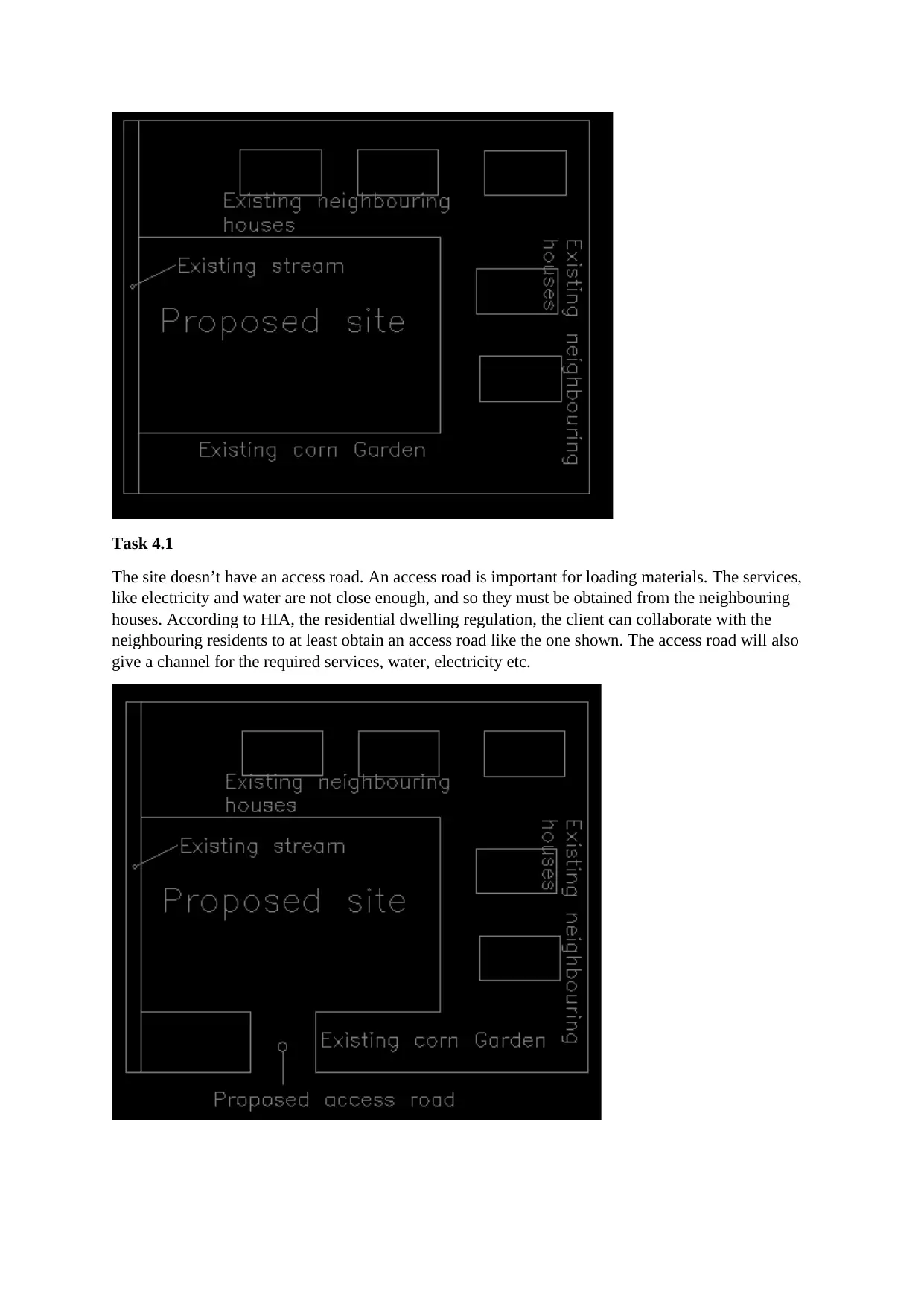
Task 4.1
The site doesn’t have an access road. An access road is important for loading materials. The services,
like electricity and water are not close enough, and so they must be obtained from the neighbouring
houses. According to HIA, the residential dwelling regulation, the client can collaborate with the
neighbouring residents to at least obtain an access road like the one shown. The access road will also
give a channel for the required services, water, electricity etc.
The site doesn’t have an access road. An access road is important for loading materials. The services,
like electricity and water are not close enough, and so they must be obtained from the neighbouring
houses. According to HIA, the residential dwelling regulation, the client can collaborate with the
neighbouring residents to at least obtain an access road like the one shown. The access road will also
give a channel for the required services, water, electricity etc.
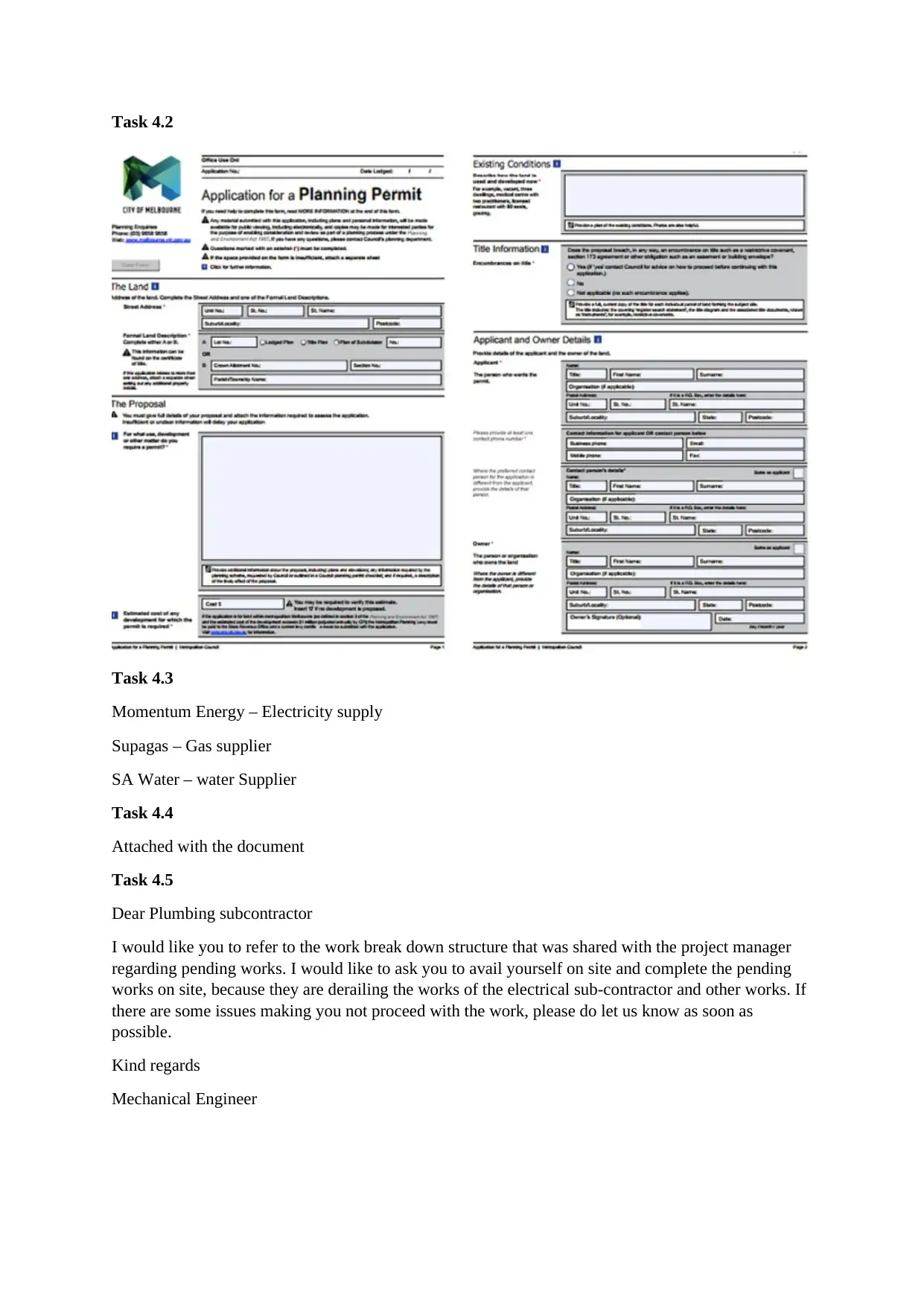
Task 4.2
Task 4.3
Momentum Energy – Electricity supply
Supagas – Gas supplier
SA Water – water Supplier
Task 4.4
Attached with the document
Task 4.5
Dear Plumbing subcontractor
I would like you to refer to the work break down structure that was shared with the project manager
regarding pending works. I would like to ask you to avail yourself on site and complete the pending
works on site, because they are derailing the works of the electrical sub-contractor and other works. If
there are some issues making you not proceed with the work, please do let us know as soon as
possible.
Kind regards
Mechanical Engineer
Task 4.3
Momentum Energy – Electricity supply
Supagas – Gas supplier
SA Water – water Supplier
Task 4.4
Attached with the document
Task 4.5
Dear Plumbing subcontractor
I would like you to refer to the work break down structure that was shared with the project manager
regarding pending works. I would like to ask you to avail yourself on site and complete the pending
works on site, because they are derailing the works of the electrical sub-contractor and other works. If
there are some issues making you not proceed with the work, please do let us know as soon as
possible.
Kind regards
Mechanical Engineer
⊘ This is a preview!⊘
Do you want full access?
Subscribe today to unlock all pages.

Trusted by 1+ million students worldwide
1 out of 30
Related Documents
Your All-in-One AI-Powered Toolkit for Academic Success.
+13062052269
info@desklib.com
Available 24*7 on WhatsApp / Email
![[object Object]](/_next/static/media/star-bottom.7253800d.svg)
Unlock your academic potential
Copyright © 2020–2025 A2Z Services. All Rights Reserved. Developed and managed by ZUCOL.





